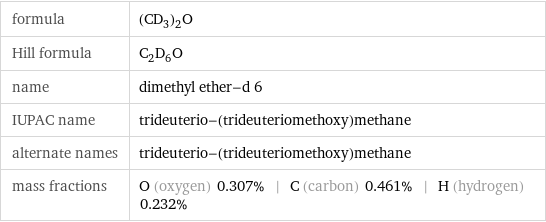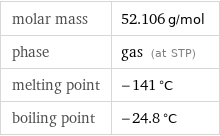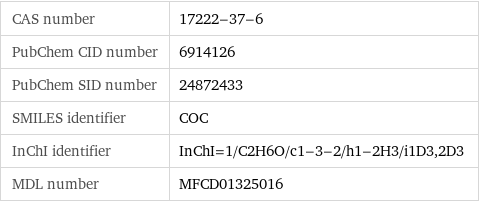Input interpretation

dimethyl ether-d 6
Chemical names and formulas

formula | (CD_3)_2O Hill formula | C_2D_6O name | dimethyl ether-d 6 IUPAC name | trideuterio-(trideuteriomethoxy)methane alternate names | trideuterio-(trideuteriomethoxy)methane mass fractions | O (oxygen) 0.307% | C (carbon) 0.461% | H (hydrogen) 0.232%
Lewis structure

Draw the Lewis structure of dimethyl ether-d 6. Start by drawing the overall structure of the molecule: Count the total valence electrons of the carbon (n_C, val = 4), hydrogen (n_H, val = 1), and oxygen (n_O, val = 6) atoms: 2 n_C, val + 6 n_H, val + n_O, val = 20 Calculate the number of electrons needed to completely fill the valence shells for carbon (n_C, full = 8), hydrogen (n_H, full = 2), and oxygen (n_O, full = 8): 2 n_C, full + 6 n_H, full + n_O, full = 36 Subtracting these two numbers shows that 36 - 20 = 16 bonding electrons are needed. Each bond has two electrons, so the above diagram has all the necessary bonds. There are 8 bonds and hence 16 bonding electrons in the diagram. Lastly, fill in the remaining unbonded electrons on each atom. In total, there remain 20 - 16 = 4 electrons left to draw: Answer: | |
3D structure

3D structure
Basic properties

molar mass | 52.106 g/mol phase | gas (at STP) melting point | -141 °C boiling point | -24.8 °C
Units

Gas properties (at STP)

vapor density | 1.62 (relative to air)
Non-standard atom properties

H-2 | 6
Chemical identifiers

CAS number | 17222-37-6 PubChem CID number | 6914126 PubChem SID number | 24872433 SMILES identifier | COC InChI identifier | InChI=1/C2H6O/c1-3-2/h1-2H3/i1D3, 2D3 MDL number | MFCD01325016